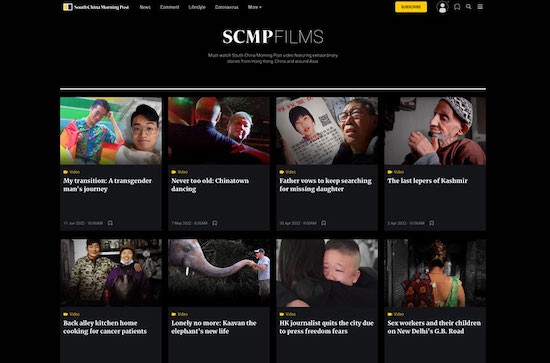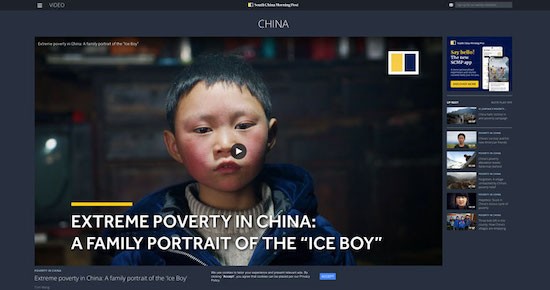Hong Kong-based South China Morning Post is using video to bring Asian cultures to its international viewership.
“When we hear from people across Asia who feel proud that their people, their communities, and the truth of their lived experience is represented, we know we are on the right track,” says director of video Mat Booth. “We know we bring something new to the media landscape and enable more people to identify with what they see on screen.”
In an INMA audio and video innovations blog, he tells how the publisher is using video journalism to deliver uniquely impactful storytelling, especially of well-developed human interest stories.
“Our video team’s vision is to elevate thought,” he says. “There is no better way to understand the various facets of social and political issues across the Asia-Pacific than showcasing the people who live that experience by using techniques that put audiences in their shoes.”

Video journalism delivers immediacy and immersion: At SCMP Films, images and spontaneous moments on camera tell the story as opposed to using a voice-over narration. “Sometimes capturing the simple things that people do on camera can be the most revealing or intimate,” Booth says.
Authentically representing subjects often means having characters tell their stories with their own voice, and most stories are told from the principal characters’ point of view. This serves to heighten the sense of connection between viewers and characters.
“We always maintain our characters can drive stories that represent larger issues or simply shine a light on the way people from different places live their lives.”
Compelling characters are sourced and discovered in many different ways – sometimes over the course of our reporting, while researching a particular issue or covering regular news. SCMP Films also collaborates with young documentary filmmakers and directors across the region, and is often introduced to characters by collaborators all over Asia.
Booth says in developing a narrative around a character, it is important to understand what will drive a story. “What is it about a character that makes them likeable and interesting? What is it about certain people and situations that can add up to more than the sum of their parts? What really attracts us are unique characters who can represent issues or a different way of life in captivating ways.”

Sometimes there are multiple characters in a story, and relationships between the main character and the supporting cast make the narrative compelling. This was the case in the story of the graduate student from a Vietnamese immigrant family in New York who decided to help his father turn business around at his restaurant as he struggled to keep it afloat during the height of the pandemic.
The character-based approach in our video stories was reinforced with coverage of the social media buzz surrounding ‘Ice Boy’ Wang Fuman, a primary school student who rose to fame after his teacher shared a photo of him with his hair frozen during a frigid winter in rural Yunnan.
“We originally went to do a news story on the impact of his new-found fame on his family, but what we found was that Fuman was such a compelling character – positive, energetic, determined, cheeky, and mischievous – and we had to produce a more immersive and experiential piece,” says Booth.
“We saw that life for his family was incredibly difficult as farmers living in poverty, gathering around a fire in their dilapidated house every night for dinner, which mainly consisted of potatoes they had harvested from the fields.
“The story wasn’t about poverty or rural development; it was about Fuman’s aspirations against the backdrop of his family’s struggles, but viewers will see all these issues through his eyes, and that was what made us fall in love with this method of storytelling.”

Booth says the approach requires spending a lot of time with subjects before the cameras even start rolling. “We often start with a character, getting to know them well before piecing together their world and their story,” he says.
“We build a level of trust and craft the piece from there. Although we do produce some of our videos by defining an objective and specifying a certain topic, a lot of our best work has started with one character that has opened our eyes to a story.”
Another endearing video story was that of “the loneliest elephant in the world” and Dr. Amir Khalil, a character clearly emotionally attached to the elephant.
Booth says SCMP bears an immense responsibility to its audience as well as to the characters and communities portrayed. “With this in mind, we have certain expectations for ourselves at the team,” he says.
“We hold ourselves to a rigorous standard of integrity, and if we find that we could have represented them more authentically, then we revisit the piece to ensure audiences see these characters on our channels the same way we did when we first found them.”
Raw metrics are measure of the success, with more than 2.8 million subscribers on YouTube, and the channel ranked in the top ten in the Tubular labs global leaderboard for video in the magazine and newspaper industry.
However, goals go further, and the team strives to showcase the best of what digital journalism can be and serve as a hub that consistently takes stories from Asia to worldwide audiences. “Ultimately, we want to give these stories a platform at SCMP as a premier destination for news, features, and analysis from Asia,” says Booth. “In this regard, video can be both an important supplement and a standalone vehicle for the Post’s award-winning journalism.”
















Comments